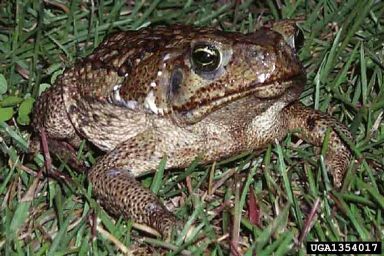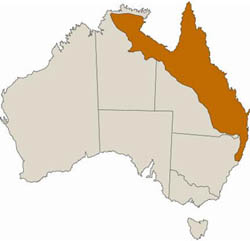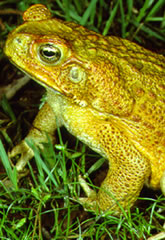|
Cane Toadsaka Bufo Marinus Consider the humble cane toad. One of nature's tiny, repugnant miracles. Not only does it have a nifty amphibious skin and excellent hopping skills, but it's loaded with enough toxins to send you down the rabbit hole faster than any red pill.
Consider the humble cane toad. One of nature's tiny, repugnant miracles. Not only does it have a nifty amphibious skin and excellent hopping skills, but it's loaded with enough toxins to send you down the rabbit hole faster than any red pill. Cane toads are indigenous to the Americas and the Carribean. They are ugly little bastards, with the emphasis on ugly rather than "little" -- they can grow to the size of gerbils. As an evolutionary protective measure, cane toads secrete a variety of poisons, mainly through gigantic glands on either side of its head which can spew venom several feet. The toad's skin and body are also infused with toxins. This makes the toad poisonous to most of its predators, but it has the odd side effect of making the toad hallucinogenic for people who lick it, or very carefully smoke or eat specific parts.
Nevertheless, the toads have traditionally used for shamanic purposes by Native Americans, and more recently used for recreational purposes by modern Americans. The toad has more nefarious uses as well. Scientist Wade Davis, author of the voodoo classic The Serpent and the Rainbow, identified the cane toad as a primary ingredient in "zombie powder," a Haitian poison used to simulate death in its victims. The hallucinogenic toad poison helped create a sense of panic in the victim, allowing the poisoner to "raise" the victim from the "dead" subject to a form of mind control. (Other ingredients in the powder included puffer fish toxin and a variety of local plants.) But cane toads aren't all about fun and toxicity. There's a dark side to the cane toad as well.
The frogs utterly failed to eat the beetles, but instead began eating everything else in sight, growing to uncomfortable sizes and breeding like there was no tomorrow. Cane toads produce tens of thousands of eggs each time they spawn, which makes for an awful lot of toads. Thanks to the aforementioned toxins, the cane toads were not susceptible to Australian predators. Instead, they became predators themselves. First, they starting consuming the food supply that had previously been the property of Australia's indigenous frogs. Then they started eating the frogs themselves -- and other creatures up to the size of mice.
Some enterprising Aussies have attempted to make the best of this, holding competitive toad races in bars, while others try to make a dime peddling cane toad leather products, as well as key chains and change purses made from whole toad carcasses, with a sales pitch based on twin appeals to patriotism and ecology. Failing to see the humor in the situation, the Australian government is simply spending millions per year on efforts to eradicate the cane toad infestation that has everyone stonkered in a wobbly with their widgeriedoos on the barbie. The latest bright idea is to introduce a genetically-modified disease that will kill the cane toads but leave everything else unharmed. Of course, this is the same sort of brilliant thinking that led to the cane toad epidemic in the first place. But then, you really aren't surprised that some people never learn, are you? |
 In addition to whatever social stigma you might incur, toad licking is a fairly dangerous activity -- the main point of poison is, after all, to kill those who ingest it. This presents a particular danger for dogs who share an ecosystem with the toads, since a dog will lick just about anything you put in front of it.
In addition to whatever social stigma you might incur, toad licking is a fairly dangerous activity -- the main point of poison is, after all, to kill those who ingest it. This presents a particular danger for dogs who share an ecosystem with the toads, since a dog will lick just about anything you put in front of it.  In 1935, the toads were introduced to Australian sugar cane farms on the theory that they would eat the greyback beetles wreaking havoc on Aussie sugar crops. The problem with this theory was simple: The beetles perch high on the sugar cane, but the toads can't jump very high.
In 1935, the toads were introduced to Australian sugar cane farms on the theory that they would eat the greyback beetles wreaking havoc on Aussie sugar crops. The problem with this theory was simple: The beetles perch high on the sugar cane, but the toads can't jump very high.  As they spread across the continent, the cane toads' toxins poisoned everything from fish and snakes to crocodiles and people. They cut a swath through Australia's diverse and unique wildlife, tacking many species to the endangered list in the process.
As they spread across the continent, the cane toads' toxins poisoned everything from fish and snakes to crocodiles and people. They cut a swath through Australia's diverse and unique wildlife, tacking many species to the endangered list in the process.